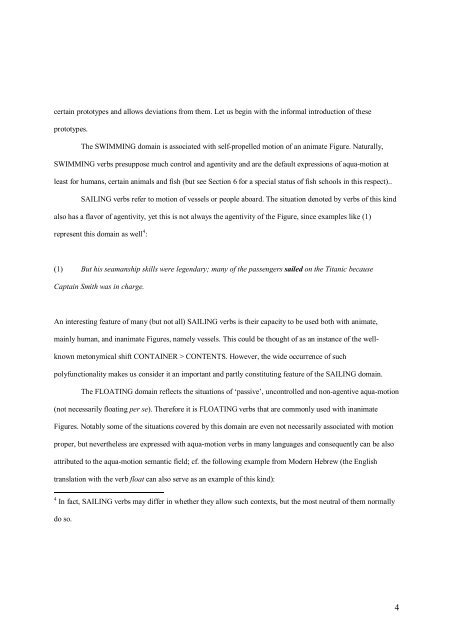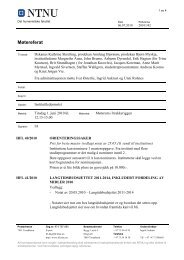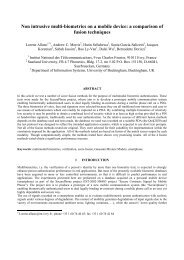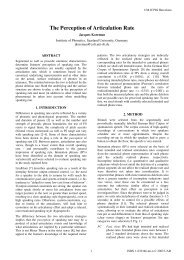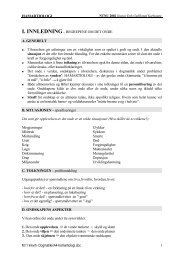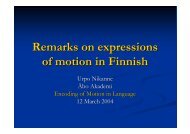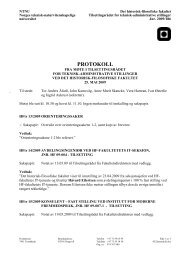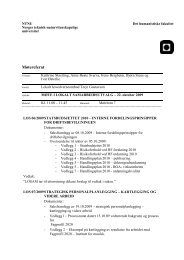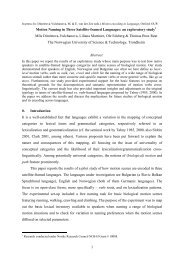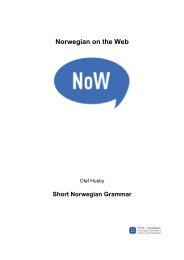Domains of aqua-motion: a case study in lexical typology Yury A ...
Domains of aqua-motion: a case study in lexical typology Yury A ...
Domains of aqua-motion: a case study in lexical typology Yury A ...
Create successful ePaper yourself
Turn your PDF publications into a flip-book with our unique Google optimized e-Paper software.
certa<strong>in</strong> prototypes and allows deviations from them. Let us beg<strong>in</strong> with the <strong>in</strong>formal <strong>in</strong>troduction <strong>of</strong> these<br />
prototypes.<br />
The SWIMMING doma<strong>in</strong> is associated with self-propelled <strong>motion</strong> <strong>of</strong> an animate Figure. Naturally,<br />
SWIMMING verbs presuppose much control and agentivity and are the default expressions <strong>of</strong> <strong>aqua</strong>-<strong>motion</strong> at<br />
least for humans, certa<strong>in</strong> animals and fish (but see Section 6 for a special status <strong>of</strong> fish schools <strong>in</strong> this respect)..<br />
SAILING verbs refer to <strong>motion</strong> <strong>of</strong> vessels or people aboard. The situation denoted by verbs <strong>of</strong> this k<strong>in</strong>d<br />
also has a flavor <strong>of</strong> agentivity, yet this is not always the agentivity <strong>of</strong> the Figure, s<strong>in</strong>ce examples like (1)<br />
represent this doma<strong>in</strong> as well 4 :<br />
(1) But his seamanship skills were legendary; many <strong>of</strong> the passengers sailed on the Titanic because<br />
Capta<strong>in</strong> Smith was <strong>in</strong> charge.<br />
An <strong>in</strong>terest<strong>in</strong>g feature <strong>of</strong> many (but not all) SAILING verbs is their capacity to be used both with animate,<br />
ma<strong>in</strong>ly human, and <strong>in</strong>animate Figures, namely vessels. This could be thought <strong>of</strong> as an <strong>in</strong>stance <strong>of</strong> the wellknown<br />
metonymical shift CONTAINER > CONTENTS. However, the wide occurrence <strong>of</strong> such<br />
polyfunctionality makes us consider it an important and partly constitut<strong>in</strong>g feature <strong>of</strong> the SAILING doma<strong>in</strong>.<br />
The FLOATING doma<strong>in</strong> reflects the situations <strong>of</strong> ‘passive’, uncontrolled and non-agentive <strong>aqua</strong>-<strong>motion</strong><br />
(not necessarily float<strong>in</strong>g per se). Therefore it is FLOATING verbs that are commonly used with <strong>in</strong>animate<br />
Figures. Notably some <strong>of</strong> the situations covered by this doma<strong>in</strong> are even not necessarily associated with <strong>motion</strong><br />
proper, but nevertheless are expressed with <strong>aqua</strong>-<strong>motion</strong> verbs <strong>in</strong> many languages and consequently can be also<br />
attributed to the <strong>aqua</strong>-<strong>motion</strong> semantic field; cf. the follow<strong>in</strong>g example from Modern Hebrew (the English<br />
translation with the verb float can also serve as an example <strong>of</strong> this k<strong>in</strong>d):<br />
4 In fact, SAILING verbs may differ <strong>in</strong> whether they allow such contexts, but the most neutral <strong>of</strong> them normally<br />
do so.<br />
4


